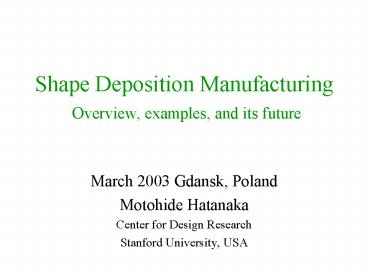Shape Deposition Manufacturing Overview, examples, and its future - PowerPoint PPT Presentation
1 / 22
Title:
Shape Deposition Manufacturing Overview, examples, and its future
Description:
Shape Deposition Manufacturing Overview, examples, and its future March 2003 Gdansk, Poland Motohide Hatanaka Center for Design Research Stanford University, USA – PowerPoint PPT presentation
Number of Views:1192
Avg rating:3.0/5.0
Title: Shape Deposition Manufacturing Overview, examples, and its future
1
Shape Deposition Manufacturing Overview,
examples, and its future
- March 2003 Gdansk, Poland
- Motohide Hatanaka
- Center for Design Research
- Stanford University, USA
2
http//www.lib.utexas.edu/maps/world.html http//w
ww.geneve-tourisme.ch/ http//www.jnto.go.jp/eng/R
TG/RI/index.html
http//www.u-tokyo.ac.jp/ http//www.stanford.edu/
3
Design and fabrication of insect-inspired robots
by shape deposition manufacturing
4
Examples of rapid prototyping methods
- Stereo Lithography
- 3D Printing (http//www.mit.edu/tdp/)
- Selective Laser Sintering
- Fuse Deposition Manufacturing
Selective curing, bonding, sintering, or
deposition in layers
5
Limitations of commonrapid prototyping methods
- Material variation
- Functionality of the product
- Fabrication tolerance
- Requires special equipment
6
Why not add material in bulk and then selectively
remove?
7
SDM advantages over common rapid prototyping
methods
- Limited material variation
- Non-functional product
- Limited fabrication tolerance
- Requires special equipment
- Wide variety of materials
- Functional product
- Fabrication tolerance comparable to conventional
machining - Conventional machining tools used.
- Can embed parts (sensors, actuators,
reinforcement)
8
SDM capabilities
Multi-material molding
Component embedding
9
Fabric-reinforced flexural hinges
Left Kinematic prototype of stroke extension
linkage with 31 parts Center Single component
SDM linkage with thick flexures Right SDM
linkage with thin fabric-reinforced flexures
(2001)
10
SDM is suited for complex integration
- Material properties can be locally altered by
multi-material fabrication. - Components can be assembled without fasteners,
hence easier and more room for complex
integration. - Semi-automated process allows detailed
fabrication.
11
Biology is a target for complex integrated
structures manufacturing
12
Cross-boundary embedding
Insert
Material A
Material B
Challenge Selectively adding, removing or
otherwise processing material around the flexible
strands without damaging them or being hindered
by them.
13
Selective deposition
Embedded component
Sacrificial material
Selective deposition
Partially embedded.
Cross-boundary embedded.
Selective deposition of part material
Selective deposition of sacrificial material
14
Capillary effect for selective deposition
Example Small string-suspended gimbals with two
rotational degrees of freedom. Developed for
attitude control of solar panels on a small
satellite (100mm-side cube).
15
(No Transcript)
16
Selective removal
Excessive deposition
Selective removal
Selective removal of part material
Selective removal of sacrificial material
17
Manual Selective Removal
Example Spring-loaded hinge with partially
embedded coil-spring and fiber-reinforced
flexure. Developed for deploying solar-panels for
a small satellite.
18
(No Transcript)
19
Material property alteration by post-processing
Material property alteration. E.g. by heat
treatment, light exposure, or material addition.
20
Selective removal by photo-lithography
Example A small flexural hinge with embedded
electrical wires.
21
(No Transcript)
22
What was SDM?
Rapid production method with repetitive addition
and selective removal of materials. It uses
conventional machining facilities, hence also
achieves the same order of machining tolerances.
Multi-material parts can be created to compose
functional mechanisms, also with embedded
functional parts such as sensors and actuators.
Cross-boundary embedding is the key for realizing
highly integrated structures.
http//www-cdr.stanford.edu/biomimetics Motohide
Hatanaka motohat_at_cdr.stanford.edu































